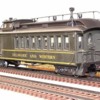Hey all.
I'm doing an art project and looking for some inspiration and stuff for some fiction I plan to write. Does anyone have examples of typical rolling stock (locomotives, cabooses, boxcars, flatcars, passenger cars...etc.) of any kind (although right now I'm in the market for cabooses) from the old west/civil war era? Models or real trains are appreciated.
Thanks
Replies sorted oldest to newest
I believe, as l blow it up, that last car with the clerestory says "caboose" on it. As a caboose nut, l find that very interesting. The big book on Mopac cabooses, l remember as showing a railyard full of very early cabooses, which l understand were windowed box cars as shown in the Civil War photos above. Looks like what you are looking for .
Attachments
colorado hirailer posted:I believe, as l blow it up, that last car with the clerestory says "caboose" on it. As a caboose nut, l find that very interesting. The big book on Mopac cabooses, l remember as showing a railyard full of very early cabooses, which l understand were windowed box cars as shown in the Civil War photos above. Looks like what you are looking for .
very interesting. Definitely not what i usually think of when I think of a Caboose.
Those are very cool.
There is an O gauge Woodside Rivarossi ICRR bobber and aa Lione ATSF Woodside I'd put pre turn of the century, MTH Overlands and Lionels W&ARR, and bobber cabooses closer to an "idealised" view of what I sort of "need" to see to achieve an end, but really longed to see more like the above from when the "real caboose" evolved from old cars. ... I mean who had the first coopla? Was it simply a wrecked celest. roof end closed off flat or something?
I need to move an album to post them.
MTH/Railking has (had?) a pretty nice line of earlier period rolling stock, including boxcars, reefers, gondolas, tank cars and cabeese. The four-wheel bobber caboose was fairly common.
As for the first cupola, it was just a hole in the top of a box car with a chair stacked on boxes that the conductor could sit in with his head sticking up through the hole. There are several good books on the caboose if you're interested.
IF you are fussy about historical accuracy:
Great strides were made during the war in size, types, and flexibility of rolling stock as well as engine design. You will, of course, see antebellum and wartime equipment persist into later decades, but you won't see the later types in a wartime setting.
We tend to lump all 19th century equipment into one category, but equipment from 1860 was, roughly speaking, as different from equipment from 1890 as equipment from 1960 is different from equipment from 1990: same basic technology but many refinements, increases in capacity, and changes in appearance.
That said, if you are NOT fussy, very few people will ever notice.
For wartime equipment, see if you can find Ed Alexander's book, Civil War Railroads and Models. That big company with the smile on the box appears to have copies available .
As for the evolution of the caboose, there are lots of legends, piles of conflicting data, oodles of pics, and no solid answers.
Attachments
Attachments
Attachments
Train classifications in the early to middle 1800s were not as rigid as most became later. Railroads frequently would run mixed trains, so space could be set aside in one of the passenger cars for the conductor. Or a freight train might devote a couple of cars to LCL freight picked up along the way, and space could be set aside in one of the LCL cars for the conductor. In those days the brakeman wouldn't need more than a minimal amount of space to store supplies. His normal job would have been to ride on the cars to set the hand brakes when needed.

Attachments
This is the book to have. Sort of a classic.
There were also "drover's way cars" in the West. These were put on the end of cattle trains and cattle owners would ride in them to the stockyards to sell their cattle. Two are left with a restored one in South Dakota.
Drovers Waycar #10800
https://www.1880train.com/coach_10800.html
Kent in SD
briansilvermustang posted:
This looks like the conductor would have a interesting trip up there. Cant imagine what would happen if the train stopped suddenly.
PR&NJRR posted:Cant imagine what would happen if the train stopped suddenly.
Watch Emperor of the North to see what happens...
smd4 posted:PR&NJRR posted:Cant imagine what would happen if the train stopped suddenly.
Watch Emperor of the North to see what happens...
ill have to do that sometime.
Steam into History runs a replica of a Civil War passenger train (completed in 2013) on the historic Northern Central Railway between New Freedom and Hanover Junction south of York, PA. Click on this link: https://www.youtube.com/watch?v=vhQHTLssIMk































